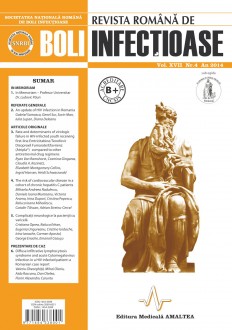SELECT ISSUE

Indexed

| |

|
|
|
| |
|
|
|

|
|
|
|
|
|
| |
|
|
HIGHLIGHTS
National Awards “Science and Research”
NEW! RJID has announced the annually National Award for "Science and Research" for the best scientific articles published throughout the year in the official journal.
Read the Recommendations for the Conduct, Reporting, Editing, and Publication of Scholarly work in Medical Journals.
The published medical research literature is a global public good. Medical journal editors have a social responsibility to promote global health by publishing, whenever possible, research that furthers health worldwide.
THE RISK OF CARDIOVASCULAR DISEASE IN A COHORT OF CHRONIC HEPATITIS C PATIENTS
Mihaela Andreea Radulescu, Daniela Ioana Munteanu, Victoria Arama, Irina Duport, Cristina Popescu, Raluca Ioana Mihailescu, Catalin Tiliscan and Adrian Streinu-Cercel
ABSTRACT
Background. The idea of a relationship between HCV infection and host lipid and glucid homeostasis is widely accepted, with an impact on liver disease progression. However, the association between HCV infection and cardiovascular (CV) risk is controversial.
Aim. This study aimed to evaluate the cardiovascular risk according to Framingham score in a cohort of HCV infected patients.
Methods. We conducted a cross sectional analysis on a cohort of 117 HCV infected patients compared to 30 controls. We recorded demographical data, HCV infection history, behavioral CV risk factors, personal and family history of CV events. We obtained fasting serum samples for lipid profile, glucid parameters, liver aminotransferases. Liver histology was assesed with Fibromax tests. CV risc was assesed with Framingham risk score. This is an interim analysis.
Results. Framingham risc score was similar in the two groups. Regarding behavioral CV risk factors, in HCV group significantly more patients declared low fat diet and higher fresh fruits and vegetables intake. Conversely, the HCV group reported lower physical activity levels. In bivariate analysis Framingham score was correlated to liver fibrosis, activity, steatosis and steatohepatitis scores (Spearman Coefficients 0.510, 0.365, 0.466 0.433, p<0.001 for all comparisons). However in logistic regression this associations were not statistically significant.
Conclusion. CV risk assesed by Framingham score was similar in HCV infected and uninfected patients, although it is possible that Framingham score underestimates CV risk in HCV infected patients.
Keywords: cardiovascular risk, Framingham risk score, chronic hepatitis, HCV
